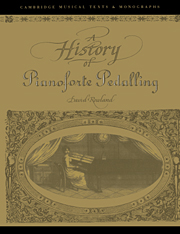Book contents
- Frontmatter
- Contents
- Acknowledgements
- List of abbreviations
- Introduction
- PART I The instruments
- 1 The transition from the harpsichord and clavichord to the piano
- 2 Stops, levers and pedals
- PART II Pedalling and the early pianists
- PART III Pedalling after c.1800
- APPENDIX: Chapters on pedalling from piano tutors
- Notes
- Select bibliography
- Index
1 - The transition from the harpsichord and clavichord to the piano
Published online by Cambridge University Press: 16 November 2009
- Frontmatter
- Contents
- Acknowledgements
- List of abbreviations
- Introduction
- PART I The instruments
- 1 The transition from the harpsichord and clavichord to the piano
- 2 Stops, levers and pedals
- PART II Pedalling and the early pianists
- PART III Pedalling after c.1800
- APPENDIX: Chapters on pedalling from piano tutors
- Notes
- Select bibliography
- Index
Summary
The early history of the piano
The history of the piano begins in Italy. Bartolomeo Cristofori, the piano's inventor, appears to have begun work on the instrument as early as 1698. His pianos were described in detail by Maffei in 1711: three of them survive in various parts of the world today. Cristofori's work became well known during his lifetime: pianos by him or his pupils were found in Italy and the Iberian Peninsula and a translation of Maffei's description was published in Hamburg by Mattheson in his Critica Musica of 1725. In the same year the Augsburg instrument maker Johann Cristoph Leo advertised ‘Cimbalen ohne Kiele’ (‘harpsichords without quills’) – presumably pianos – in the Viennese press. Meanwhile, Schröter had exhibited some experimental instruments in Dresden.
By 1758 the piano was apparently known in a number of places, according to Adlung in his Anleitung zu der musikalischen Gelahrheit (Erfurt, p. 563). He had not seen one himself, but he does nevertheless mention one of the most important early makers of the instrument in Germany, Friederici. Adlung returned to the history of the piano in a later publication in which he goes into far greater detail, devoting much space to the work of another maker, Gottfried Silbermann. Silbermann was making pianos in the early 1730s, but his most famous instruments were those purchased by Frederick the Great in the 1740s, two of which still survive, along with another instrument, now in Nuremberg. The Silbermann family were probaby the most important makers of the piano in the mid eighteenth century.
- Type
- Chapter
- Information
- A History of Pianoforte Pedalling , pp. 7 - 13Publisher: Cambridge University PressPrint publication year: 1993



